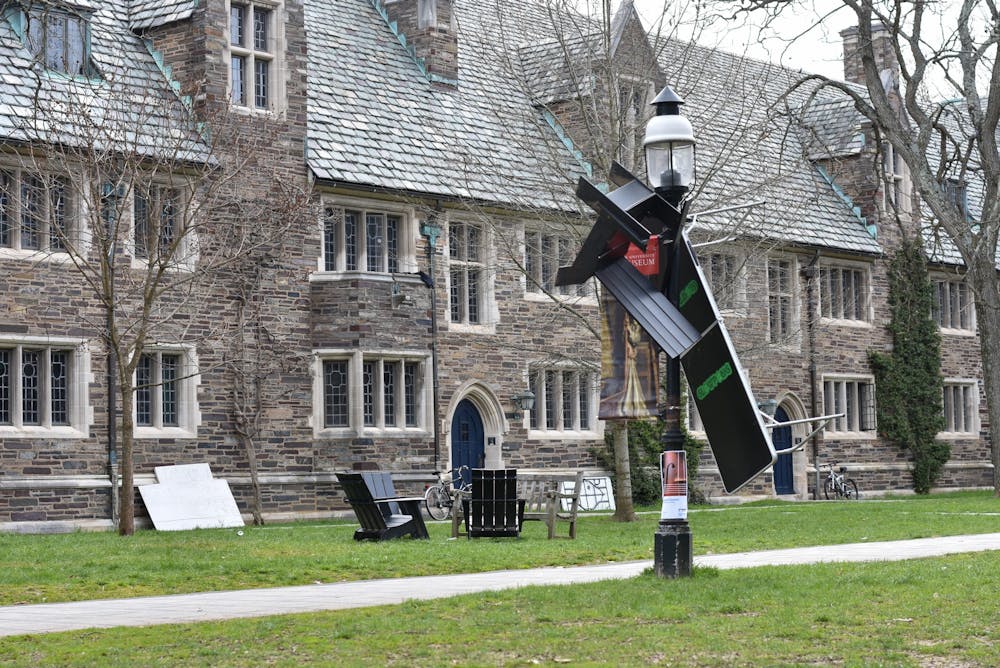As move-out approached, Princeton students flocked to residential college listservs and online marketplaces to sell their unwanted or unstorable clothes and dorm items. Typically referred to as “Senior Sales,” these sales are typically advertised with a Google Slides presentation of priced items and sell a mix of clothes, furniture, and technology. The Daily Princetonian collected data on 172 sales from March 15 to May 21 through the listserv management tool Hoagie Mail to explore Princeton’s market of virtual garage sales.
Despite their common moniker of Senior Sale, just 115 of 172 of sales were actually posted by members of the Class of 2023. The next most sales were from the Class of 2024 with 24, followed by 2025 with 22 sales and 2026 with eight. Three sales were by recently graduated students in the Classes of 2022 and 2021, possibly in graduate programs or selling through a friend.
Princeton students preferred to use Hoagie Mail’s Marketplace feature to promote their sales, with all but 40 sales in our dataset using it to sell their items. Part of Hoagie Digest, the Marketplace feature allows several sales, bulletins, and notices to be condensed into one email rather than many, eliminating clutter in students’ inboxes. 120 students used Hoagie Marketplace exclusively to promote their sales, while 12 used both a listserv email and Marketplace.
Nearly 58 percent of sales were posted after Dean’s Date, implying that many Princeton students waited until after reading period to begin packing up their dorms. The large spike in sales after Dean’s Date was mirrored by a similar spike following the last day of class on April 28.

60 of the 172 sales we tracked “bumped” their sale at some point, meaning they sent at least one additional email or Hoagie Marketplace post to promote their sale once more. 21 sales bumped a second time, while six sent a third bump. Two sales sent a fourth reminder, and out of those two sales, one sale was bumped five times. When looking at the average time between bumps, the average time elapsed from the initial email or posting to the first bump was just over ten days, with the second bump, if sent, coming just under six days later on average.
Over 80 percent of sales sold clothing, and of these, almost 83 percent sold women’s clothing. Just 24 of the 138 sales that sold clothing offered men’s clothing.
Across both styles of clothing, small and medium sizes were most commonly offered, with about 70 percent of clothing sales selling one of these sizes. Just 15 percent of men’s and 12 percent of women’s clothing sales offered sizes large and above, while about 13 percent of men’s and 18 percent of women’s clothing sales sold extra small or extra extra small-sized clothes.
Beyond clothes, many students sold dorm items like mini-fridges and fans. The ‘Prince’ tracked the asking prices of these popular items in addition to full-length mirrors, couches and futons, and rugs to see how much students sought to obtain for their dorm items. The average asking price of a mini-fridge was $56, ranging wildly from $20 to $150. The range of asking prices for futons and couches was even broader, stretching from $10 up to $300. The average asking price for a couch or futon was $84.
Box or stand fans were more consistent, averaging $12 and ranging from $3 to $20. Full-length mirrors were similar, ranging from $5 to $25 and averaging $10. Rugs, however, encompassed a broad range of prices, with some rugs put on sale for as low as $10 while other students sought up to $240 for their dorm carpeting. The average asking price for rugs was $54.
Rugs and fridges ranged in size, leading the ‘Prince’ to calculate the price per square foot and cubic foot for rugs and fridges, respectively. The average per square foot for rugs was $1.67, ranging from 71 cents to $3.57, while the average price per cubic foot for mini-fridges was $24.87, ranging from $15.15 to $55.55.
52 sales advertised mini-fridges, making it the most popular dorm item sold. To further examine the price of this item, the ‘Prince’ looked at how the asking price of mini-fridges changed over time. Our analysis showed that mini-fridge prices remained constant, with the first half of mini-fridges – those listed on May 12 or before – posted having an average price of $55.38, rising marginally to $57.31 after May 12. When looking at the price of fridges by the cubic foot, the first half of fridges listed (for which size data was available) had an asking price of $22.36 per cubic foot, rising to $27.38 for the second half of fridges listed.
Through listserv emails and Hoagie Marketplace posts, Princeton students put thousands of their own items up for sale as move-out approached. These sales serve as a profitable alternative to summer storage – or simply throwing items away – helping reduce waste in the process. Looking at this data shows how all classes, not just the namesake seniors, participate in the annual ritual of Senior Sales to clear out their closets, selling everything from area rugs to formal dresses.
Ryan Konarska is an associate Data editor for the ‘Prince.’
Please send corrections to corrections[at]dailyprincetonian.com.








